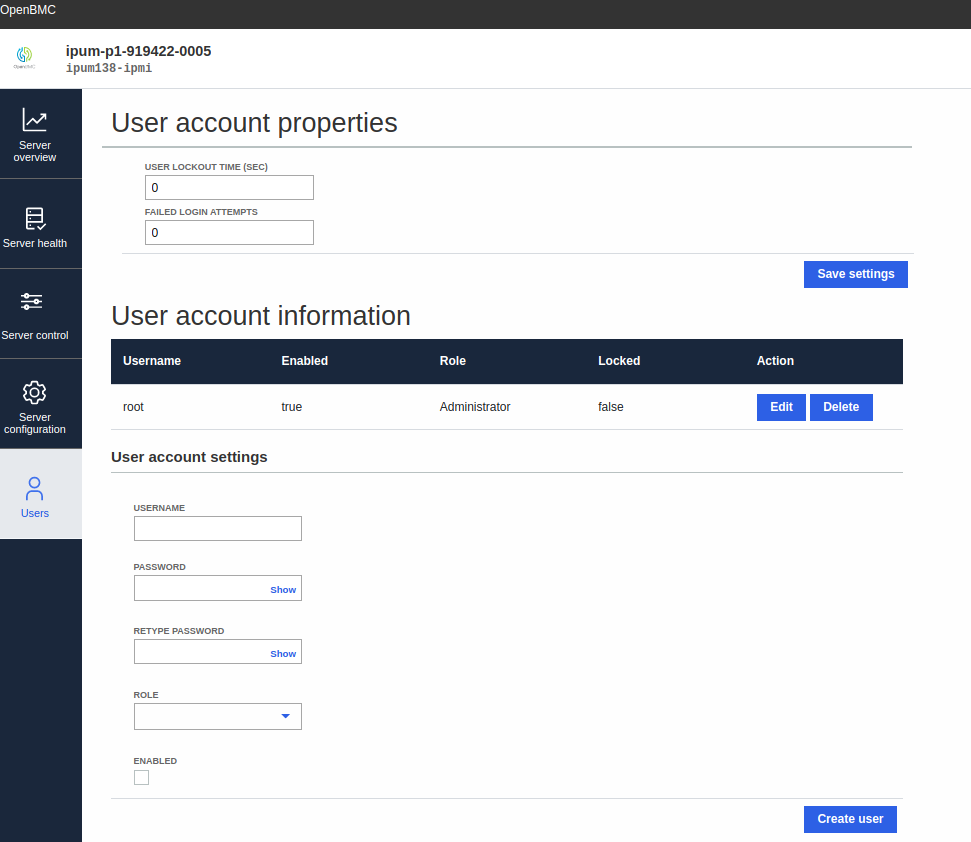8. User management
This section describes how to conduct user management operations using the BMC command, GUI, REST and Redfish interfaces. In addition, the BMC supports integrations with an LDAP server.
8.1. BMC command line
You can manage users with the standard Linux commands useradd, userdel, usermod and passwd via SSH or a serial console.
8.2. GUI
The user management operations available in the GUI are described in Table 8.1. The GUI page is shown in Fig. 8.1.
Command |
Description |
|---|---|
List users |
List users |
Create a user |
Create a user with an OpenBMC role (administrator, user, callback or operator) |
Delete a user |
Delete the user from system |
Edit a user |
Edit the user properties |

Fig. 8.1 GUI: user management operations
8.3. REST API
You can do
user management operations through the REST interface either by sending curl queries to the URI or by using the Graphcore openbmctool.py.
Table 8.2 describes the commands available.
Command |
Description |
|---|---|
|
List users on the BMC |
$ curl -k https://<bmcip>/xyz/openbmc_project/user/list -u <bmcuser>:<bmcpass>
$ python3 openbmctool.py -H <bmcip> -U <bmcuser> -P <bmcpass> local_users queryenabled
|
|
8.4. IPMI
No user management operations are available via IPMI.
8.5. Redfish
You can perform
user management through the Redfish interface either by sending curl queries or browsing the URI.
User management operations can be found in the AccountService collection available at https://<bmcip>/redfish/v1/AccountService. Table 8.3 describes the commands available.
Command |
Description |
|---|---|
Users list |
List users available on the BMC. |
$ curl -k https://<bmcip>/redfish/v1/AccountService/Accounts -u <bmcuser>:<bmcpass>
|
|
Example output from the command is shown below. The results of browsing the same endpoints is shown in user_management_redfish.
$ curl -k https://<bmcip>/redfish/v1/AccountService/Account -u <bmcuser>:<bmcpass>
{
"@odata.context": "/redfish/v1/$metadata#ManagerAccountCollection.ManagerAccountCollection",
"@odata.id": "/redfish/v1/AccountService/Accounts",
"@odata.type": "#ManagerAccountCollection.ManagerAccountCollection",
"Description": "BMC User Accounts",
"Members": [
{
"@odata.id": "/redfish/v1/AccountService/Accounts/root"
}
],
"Members@odata.count": 1,
"Name": "Accounts Collection"
}

8.6. LDAP integration
OpenBMC supports LDAP integration to both OpenLDAP and Active Directory servers.
You can set the LDAP configuration by using the busctl commands described in Table 8.4.
Command |
Description |
|---|---|
Enable LDAP |
Enable LDAP |
$ busctl set-property xyz.openbmc_project.Ldap.Config /xyz/openbmc_project/user/ldap/<ldaptype> xyz.openbmc_project.Object.Enable Enabled b true
|
|
Set LDAP server URI |
Set LDAP server URI. |
$ busctl set-property xyz.openbmc_project.Ldap.Config /xyz/openbmc_project/user/ldap/<ldaptype> xyz.openbmc_project.User.Ldap.Config LDAPServerURI s "<ldap_server_uri>"
|
|
Set LDAP Search Scope |
Set LDAP search scope |
$ busctl set-property xyz.openbmc_project.Ldap.Config /xyz/openbmc_project/user/ldap/<ldaptype> xyz.openbmc_project.User.Ldap.Config LDAPSearchScope s "<ldap_search_scope>"
|
|
Set LDAP BindDN |
Set LDAP bind DN |
$ busctl set-property xyz.openbmc_project.Ldap.Config /xyz/openbmc_project/user/ldap/<ldaptype> xyz.openbmc_project.User.Ldap.Config LDAPBindDN s "<ldap_binddn>"
Example |
|
Set LDAP BindDN PW |
Set LDAP bind DN password |
$ busctl set-property xyz.openbmc_project.Ldap.Config /xyz/openbmc_project/user/ldap/<ldaptype> xyz.openbmc_project.User.Ldap.Config LDAPBindDNPassword s "<ldap_binddn_pw>"
|
|
Set LDAP BaseDN |
Set LDAP base DN |
$ busctl set-property xyz.openbmc_project.Ldap.Config /xyz/openbmc_project/user/ldap/<ldaptype> xyz.openbmc_project.User.Ldap.Config LDAPBaseDN s "<ldap_base>"
Example |
|
Set UserNameAttribute |
Set UserNameAttribute |
$ busctl set-property xyz.openbmc_project.Ldap.Config /xyz/openbmc_project/user/ldap/<ldaptype> xyz.openbmc_project.User.Ldap.Config UserNameAttribute s "<uattr>"
Example of |
|
To use a secure LDAP connection, you need to upload and install client and root certificate authority (CA) certificates on the BMC. You can do this using the commands in Table 8.5.
Command |
Description |
|---|---|
Install client cert |
Install client certificate |
$ busctl call xyz.openbmc_project.Certs.Manager.Client.Ldap /xyz/openbmc_project/certs/client/ldap xyz.openbmc_project.Certs.Install Install s "<cert.pem>"
If successful, the client certificate will be installed in |
|
Install Root CA cert |
Install root CA certificate |
$ busctl call xyz.openbmc_project.Certs.Manager.Authority.Ldap /xyz/openbmc_project/certs/authority/ldap xyz.openbmc_project.Certs.Install Install s "<cacert.pem>"
If successful, the CA certificate will be installed in |
|
To map privileges from LDAP user groups to local user groups, use the commands in Table 8.6.
Command |
Description |
|---|---|
LDAP privilege map |
Map privileges from LDAP to local groups |
$ python3 /localdata/martinh/clean_openbmc/openbmc/ci/openbmctool.py -H <bmcip> -U <bmcuser> -P <bmcpass>
$ ldap privilege-mapper create -g <ldapgroup> -p {priv-admin/priv-user}
|
|
To display current LDAP configuration, use the commands in Table 8.7.
Command |
Description |
|---|---|
Display LDAP configuration |
Display current LDAP configuration |
$ curl -b cjar -k https://<bmcip>/xyz/openbmc_project/user/ldap/enumerate -u <bmcuser>:<bmcpass>
|
|